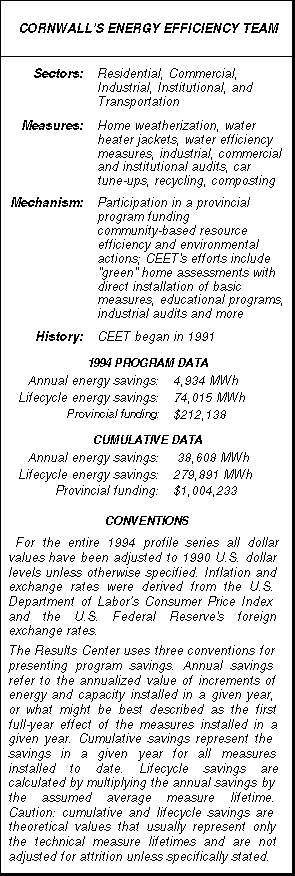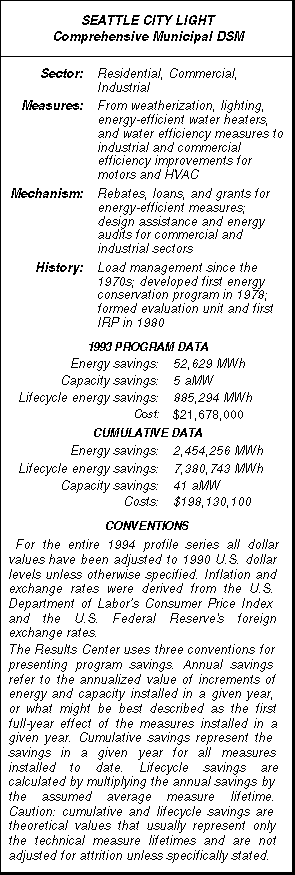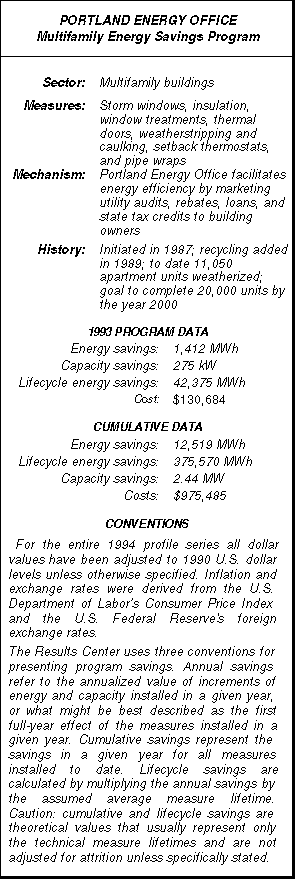EXECUTIVE SUMMARY
 The City of Cornwall’s comprehensive efficiency program is a leading model of the Ontario Ministry of Environment and Energy’s Green Communities Initiative. Thanks to effective partnerships between government, citizens, utilities, and trade allies, Cornwall has tuned-up its use of energy in homes, businesses, industry, and transportation, while creating an efficiency ethic in town to include water efficiency, use of alternative transportation fuels, recycling, and composting. The program has been delivered by Cornwall’s Energy Efficiency Team whose goals are to save energy and water, reduce waste, protect the environment, and stimulate the local economy.
The City of Cornwall’s comprehensive efficiency program is a leading model of the Ontario Ministry of Environment and Energy’s Green Communities Initiative. Thanks to effective partnerships between government, citizens, utilities, and trade allies, Cornwall has tuned-up its use of energy in homes, businesses, industry, and transportation, while creating an efficiency ethic in town to include water efficiency, use of alternative transportation fuels, recycling, and composting. The program has been delivered by Cornwall’s Energy Efficiency Team whose goals are to save energy and water, reduce waste, protect the environment, and stimulate the local economy.
Cornwall has had a long history with resource efficiency, providing home audits, shifting energy use "off-oil," relighting streetlights, and converting vehicles to natural gas. Because of Cornwall’s interest, commitment, and experience with resource efficiency, the City has the distinction of being named "Canada’s Environmentally Friendly and Energy-Efficient City." This led to the selection of Cornwall as one of three pilot communities for Ontario’s Green Communities Initiative. Thanks to provincial funding plus extensive community support, the City initiated its comprehensive community-based program in 1991.
Cornwall’s Energy Efficiency Team is based on a unique and effective partnership between Cornwall Electric, Centra Gas, the Chamber of Commerce, local school boards, the Kiwanis Club, and the Rotary Club. Since the inception of the program, nearly $2.14 million has been invested in Cornwall including $1.0 million in provincial funds and over $2.42 million from the community. This capital has leveraged $2.14 million annually in direct energy savings and perhaps as much as $5 million annually when the full economic impacts of the program are considered and accounted. Furthermore, the program has created an estimated 60 new jobs in town.
Home tune-ups are at the core of the residential initiatives. A total of 10,800 homes have been treated with CEET’s free walk-through assessments complete with direct installation of energy and water saving measures and recommendations for becoming more energy efficient and environmentally friendly. The typical customer experiences a annual savings of about $96 in energy costs with no money down! To finance the more costly recommendations, EnviroLoans are provided by Canada Trust and Green Loans are available from TD Bank. In addition to success in the residential element, Cornwall has supported retrofits in businesses, industries, schools, and hospitals, and has contributed both funding and expertise to improving transportation sector efficiency. The entire program has been so successful that it is being expanded to an entire tri-county area surrounding Cornwall.
[CLICK HERE TO DOWNLOAD THE ENTIRE 20 PAGE PROFILE IN PDF FILE FORMAT]
This profile was produced by 

 Seattle City Light, one of the nation’s largest municipal utilities, reinforces the notion that utilities can effectively offer demand-side management (DSM) services in regions characterized by low power rates. Despite rates that rank among the lowest in the nation, Seattle City Light (SCL) exemplifies dedication to public power and has proven that commitment to social concerns and energy efficiency can result in exemplary levels of savings through widespread participation in all sectors of the City’s economy. SCL’s success can also be measured by its DSM expenditures as a percentage of gross revenues: In 1993 SCL budgeted a precedent-setting 9.1% of gross revenues for DSM!
Seattle City Light, one of the nation’s largest municipal utilities, reinforces the notion that utilities can effectively offer demand-side management (DSM) services in regions characterized by low power rates. Despite rates that rank among the lowest in the nation, Seattle City Light (SCL) exemplifies dedication to public power and has proven that commitment to social concerns and energy efficiency can result in exemplary levels of savings through widespread participation in all sectors of the City’s economy. SCL’s success can also be measured by its DSM expenditures as a percentage of gross revenues: In 1993 SCL budgeted a precedent-setting 9.1% of gross revenues for DSM! The City of Portland, Oregon is a mecca of energy and environmental responsibility. In 1979, Portland became the first U.S. city to forge a comprehensive energy policy. The same year it established the Portland Energy Office. In 1993, Portland became the first U.S. city to adopt a local carbon dioxide reduction strategy, committing to reduce its CO2 emissions by 20% below 1988 baselines by the year 2010, far surpassing the levels specified as a result of the international Climate Convention that developed from the Earth Summit in Rio de Janeiro.
The City of Portland, Oregon is a mecca of energy and environmental responsibility. In 1979, Portland became the first U.S. city to forge a comprehensive energy policy. The same year it established the Portland Energy Office. In 1993, Portland became the first U.S. city to adopt a local carbon dioxide reduction strategy, committing to reduce its CO2 emissions by 20% below 1988 baselines by the year 2010, far surpassing the levels specified as a result of the international Climate Convention that developed from the Earth Summit in Rio de Janeiro. The Pacific Energy Center (PEC) is one of the leading energy centers in the United States, an impressive showcase of technologies and advanced techniques for electric and gas efficiency housed in an attractive 30,000 square foot center that has become a mecca for energy efficiency professionals in the Bay Area as well as an icon of PG&E’s emphasis on customer services. Since the Center opened in late 1991, PEC has become world renowned for its technical capabilities and mission and thus is a potent model for subsequent initiatives.
The Pacific Energy Center (PEC) is one of the leading energy centers in the United States, an impressive showcase of technologies and advanced techniques for electric and gas efficiency housed in an attractive 30,000 square foot center that has become a mecca for energy efficiency professionals in the Bay Area as well as an icon of PG&E’s emphasis on customer services. Since the Center opened in late 1991, PEC has become world renowned for its technical capabilities and mission and thus is a potent model for subsequent initiatives.